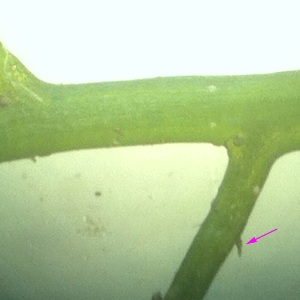2. Myriophyllum heterophyllum Michaux (N-Am.) – A rare, locally naturalised alien, probably overlooked. First recorded in a dead branch of river Meuse near Lives-sur-Meuse in 1993 (along with Lagarosiphon major; see Bouxin & Lambinon 1996) but soon gone. Recently discovered in several canals and other artificial water courses (chiefly in Antitankgracht, kanaal Dessel-Schoten) in the northern parts of the province of Antwerpen (De Beer & De Vlaeminck 2008). Most records were from 2007 but the dimensions of some populations suggest a much longer presence. One herbarium collection (Antitankgracht near Sint-Job-in-‘t-Goor) dates back to 1999. Myriophyllum heterophyllum appears to be firmly established in several localities but does not (yet) seem to spread in an invasive way. More information on the incipient invasion of Myriophyllum heterophyllum in Belgium and elsewhere in western Europe, as well as additional useful references are available at http://ias.biodiversity.be/species/show/117 and http://www.q-bank.eu/Plants/Factsheets/Myriophyllum%20heterophyllum%20NL.pdf. In the Antitankgracht Myriophyllum heterophyllum grows along with several rare and vulnerable aquatic native species (incl. Luronium natans). It often forms dense colonies and surely is more vigorous than native Myriophyllum spicatum (De Beer & De Vlaeminck 2008). Its future behaviour should be monitored.
At anthesis Myriophyllum heterophyllum is very typical with its conspicuous floral bracts and then confusion with other species is excluded (except perhaps with M. simulans Orchard, see below). However, it more often spreads vegetatively and probably only rarely flowers (that is doubtlessly why it was overlooked for quite some time). According to Wimmer (1997) and De Beer & De Vlaeminck (2008) it can be identified on the basis of some microscopic features (presence and distribution of mucous papillae) (see these papers for details). Myriophyllum heterophyllum is furthermore distinguished by vegetative shoots rounded at apex (rather truncate in M. spicatum) and its leaves are inserted at nearly right angles (very oblique and with ultimately curved segments in M. spicatum).
The exact origin of European populations of Myriophyllum heterophyllum is rather obscure. It is known since the 1940’s from Germany (Wimmer 1997, Hussner & al. 2005). Wann (1997) does not cite it as an ornamental in European gardens (see however Jäger & al. 2008). It most likely was introduced as an aquarium plant and managed to escape (from discarded aquarium contents).
A very similar Australian species (likewise with conspicuous floral bracts) is also cultivated an an ornamental in Europe, Myriophyllum simulans (see Jäger & al. 2008). It is best distinguished in having 8 stamens, not 4. It is not impossible that these two species are intermixed.
 |
 |
 |
 |
Selected literature:
Bouxin G. & Lambinon J. (1996) Deux xénophytes aquatiques nouveaux pour la Belgique, Myriophyllum heterophyllum et Lagarosiphon major, dans la Meuse à Lives-sur-Meuse (province de Namur). Nat. Mosana 49 : 94-97.
Casper S.J., Jentsch H. & Gutte P. (1980) Beiträge zur Taxonomie und Chorologie europäischer Wasser- und Sumpfpflanzen. 1. Myriophyllum heterophyllum bei Leipzig, Finsterwalde und Spremberg. Hercynia 17(4): 365-374.
Cirujano S., Stübing G., Peris B. & Medina L. (1997) Myriophyllum heterophyllum naturalized in Spain. An. Jard. Bot. Madrid 55(1): 164-165.
De Beer D. & De Vlaeminck R. (2008) Myriophyllum heterophyllum, een nieuwe invasieve waterplant. Dumortiera 94: 8-13.
Hussner A. & Krause T. (2007): Zur Biologie des aquatischen Neophyten Myriophyllum heterophyllum Michaux in Düsseldorfer Stadtgewässern. Acta Biologica Benrodis 14: 67-76.
Hussner A., Nienhaus I. & Krause T. (2005) Zur Verbreitung von Myriophyllum heterophyllum Michx. in Nordrhein-Westfalen. Flor. Rundbr. 39: 113-120.
Jäger E.J., Ebel F., Hanelt P. & Müller G. (eds.) (2008) Rothmaler Band 5. Exkursionsflora von Deutschland. Krautige Zier- und Nutzpflanzen. Springer Verlag, Berlin: 880 p.
Peeters G.M.T. (2004) Een vreemd vederkruid in het Zwartwater: Myriophyllum heterophyllum Michx. Natuurhist. Maandbl. 93(8): 251-252.
Pietsch W. & Jentsch H. (1984) Zur Soziologie und Ökologie von Myriophyllum heterophyllum Mich. in Mitteleuropa. Gleditschia 12: 303-355.
Spangehl B. & Scharrenberg U. (1985) Das Wechselblättrige Tausendblatt (Myriophyllum heterophyllum) im Heider Bergsee bei Brühl (Erftkreis, NRW). Flor. Rundbr. 85(2): 98-100.
Wann J.D. (1997) Myriophyllum. In: Cullen J. & al. (eds.), The European Garden Flora, vol. 5. Cambridge University Press, Cambridge: 358.
Wimmer W. (1997) Myriophyllum heterophyllum Michaux in Niedersachsen und Bremen sowie seine Bestimmung im vegetativen Zustand. Flor. Rundbr. 31: 23-31.
Wimmer W. & Schrei J. (1995) Verschiedenblättriges Tausendblatt Myriophyllum heterophyllum Michaux in Niedersachsen eingebürgert. Naturschutz Nachrichten Salzgitter 15-16: 20-22.

